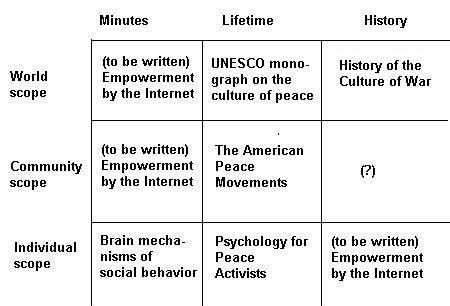Stories
The Seville Statement Newsletter
Mayor DiLieto and the Peace Commission
Plans for
a general human theory
Facing the internal culture of war
Student Conferences at Wesleyan
Shell mobiles
* * *
The Seville Statement on Violence
As I stepped back and looked at my writings at the beginning of the 1990's, I saw a pattern which began to fill in all levels of time and space for a general theory of human behavior: individual, community and world space; minutes, lifetimes, and all of history in time.
When graphed, it looked like this:

Some of the cells were filled in to my satisfaction.
With regard to the mechanisms of the individual social over the span of minutes, I felt that I had gone as far as brain research would permit. Obviously, one would like to know about the mechanisms of language, but the data was nowhere near available.
 Psychology for Peace Activists, as far as I was concerned, was as advanced as we could go at this point in understanding consciousness development of the individual. The analysis worked for revolutionaries, and although I had not formally applied it, I found good coherence when I looked at the autobiographies of great scientists.
Psychology for Peace Activists, as far as I was concerned, was as advanced as we could go at this point in understanding consciousness development of the individual. The analysis worked for revolutionaries, and although I had not formally applied it, I found good coherence when I looked at the autobiographies of great scientists.
As far as social movements were concerned, I had gone as far as I could with the history of American peace movements, and was convinced that a similar analysis could be done for other social movements in other countries as well.
Once I was at UNESCO, I could apply a similar analysis on a global scale which I did in the monograph, looking at culture of peace on the levels of international, national and local levels.
This left me several cells yet to fill. For many years I worked on materials for a World History of the War/Peace Dialetic. Although in recent years I have put less energy into it, there are several drafts waiting to be moved further forward. [note added in 2009. I have now completed and published this work under the title History of the Culture of War.
For a long time I did not see how to deal with world and community interactions on a minute-by-minute level or how to deal with the evolution of the individual's or community's capacities over the span of recorded history. Finally, I decided that this could be done using the Internet and its precedents as a reference point for how human social interactions have evolved. Having worked by using Internet for several years, I continue to think about how to approach this analysis.
 |
Stages
1986-1992
Fall of Soviet Empire
1992-1997
UNESCO Culture of Peace Programme